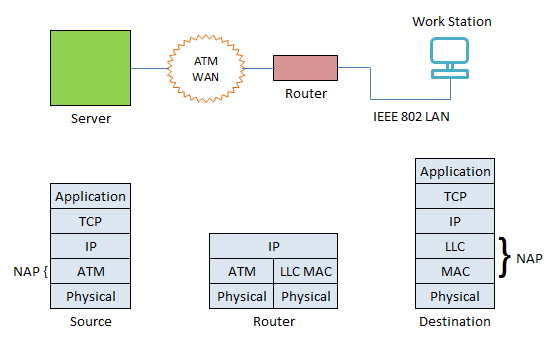Internetworking
An inter-connected set of networks from a user's point of view might appear as a single larger network.
An interconnected set of private networks form the Internet.
Each device present in a consistent and sub network is called an end system. Each sub network is inter connected with another sub network via special devices known as intermediate systems.
Two commonly used types of intermediate systems are:
1. Routers and
2. Bridges
The difference between a bridge and router is, in which layer? It operates in the GST model. A bridge operates in the Data link layer while a router operates in the network layer.
Functions of a Router
1. It should provide a link between the networks.
2. It should deliver the data packets to destination network.
3. It should provide these functions without involving any modifications to the network architecture of intermediate networks.
How does the Internet work?
Assume a server attached to an ATM WAN and a work station attached to as IEEE-802 LAN with a router connecting these to networks as shown below:

Now if some data has to be transferred from the source to the work stations via the Router, each of them should perform certain actions.
Actions of the Source
The different actions that should be performed by the Sender (Source) are listed below:
1. Preparing the data
Before the data is transmitted, it should be prepared for transmission. This is done by the applications that are present in the application layer of the sender.
2. Using a common syntax
Sometimes the data should be converted into a suitable form as required by the destination, before transmission.
3. Segmenting the data
When this block of data is handled over to the TCP layer it breaks the data into a set of segments each of which includes a segment header that contains the segment number and other information.
4. Duplicating segments
A copy of each segment is made and stored on the sender. In case of loss of these segments during transmission, these duplicated segments are retransmitted. They are only removed when the sender receives an acknowledgement from the receiver.
5. Fragmenting the segments
The TCP segments are now handed over to IP which encapsulates the segment into datagrams. Each datagram includes a header that contains destination address and other control information.
6. Framing
The datagrams are now handed over to the network layer that consists of ATM which converts them into frames or cells. Each frame includes an ATM header that contains a connection identifier and other information.
7. Transmission
The ATM cells are now handed over to the physical layer which transmits them over the network as the sequence of bits.
Actions of the Router
The different actions that should be performed by the Routers are:
1. Receiving the Cell
The physical layer of the Router receives the data as a cell of bits.
2. Perceiving the cell
The ATM layer removes the Cell Header and processes it.
3. Routing the packet
IP examines the IP header and determines the route to reach the specified destination and then passes the datagram to the link layer (LLC) for transmission.
4. Forming LLC PDU
An LLC header is added to the datagram to form as LLC PDU.
5. Framing
The MAC layer adds a MAC header at the beginning and a trailer at the end of LLC PDU to form a frame.
6. Transmission
Each frame is then transmitted as a stream of bits.
The different actions that should be performed by the receiver are:
Actions of the Destination
1. Receiving the Bits
The stream of bits are received at the physical layer of the receiver.
2. Processing the Frame
This stream of bits is handed over to the MAC layer which removes the MAC header and trailer and processes the Frame.
3. Processing the LLC PDU
The frame is handed over to LLC that removes the LLC header and does the processing of the LLC PDU.
4. Processing the IP Datagram
After removing the LLC header from the LLC PDU the resulting datagram is hand over to IP which removes the IP header and processes the IP datagram.
5. Processing the TCP Segment
After removing the IP header from the IP datagram, the resulting segment is handed over to TCP which removes the segment header and processes it.
6. Reassembling the user data
After removing the segment header, the resulting data is reassembled to form block of data which is now passed on to the specified application.
7. Delivering the data
Before the user data is passed on to the application, it is converted back to its original format and later is delivered on the specified application.
Average Acceleration Calculator
Average acceleration is the object's change in speed for a specific given time period. ...
When an object falls into the ground due to planet's own gravitational force is known a...
In Mathematics, the permutation can be explained as the arrangement of objects in a particular order. It is an ordered...
A rectangle can be explained as a 4-sided quadrilateral which contains equal opposite sides. In a rectangle
A three sided polygon which has three vertices and three angles is called a triangle. Equilateral triangle...






